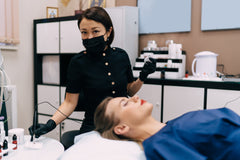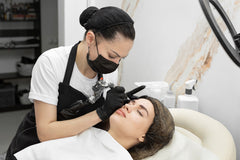📦 Free Shipping for orders of $300 or more. USPS Priority Mail Express days only applies when ordered before 1:00 pm California time. 🔷 Become a BC Member and receive free shipping on all orders no minimums! Free shipping is only offered to USA and Puerto Rico orders. Learn More >> 🔷
📦 Free Shipping for orders of $300 or more. USPS Priority Mail Express days only applies when ordered before 1:00 pm California time. 🔷 Become a BC Member and receive free shipping on all orders no minimums! Free shipping is only offered to USA and Puerto Rico orders. Learn More >> 🔷
What's In Your Microblading Pigments?

What's In Your Microblading Pigments?
- Admin .
- -
- Jan, 30 , 22
Our eyebrows are an important part of our face. Beyond their function of keeping the eyes protected from dust, dirt, and sweat, our brows are significant for emotional expression. They also structure our faces and help with facial recognition. But not all of us are lucky enough to have well-defined natural brows. This is why microblading quickly became a demand among beauty treatments.
Microblading is a semi-permanent solution that involves inserting pigment into the skin. Thus, it must only be done by a trained professional who is aware of the quality of their products, most especially the microblading pigments used. In addition, manufacturers should prove their formula is safe to use.
What are the pigments made of?

Microblading pigments are made of colorants and carriers. The colorants are the ones that provide the color of the pigments. And the carriers, which are usually inactive ingredients, are transporting agents that help the color apply onto the skin. Carriers can be glycerin, alcohol, witch hazel, etc.
But poor quality pigments saturate the markets nowadays. These pigments contain metals or compounds such as titanium dioxide or iron oxide. Manufacturers usually mix them in to reduce costs. But it’s a big health risk for consumers. There could be adverse reactions or harmful long-term effects to those who get their microblading done with these dubious pigments. However, some brands, like PhiBrows, are producing organic/inorganic pigments. Organic ones use fruit or vegetable-based pigments. They even last longer and look more natural than inorganic ones containing iron oxide, and when you combine them you take the best from both.
Know your pigments

Whether you’re the one getting the procedure or the one doing it, make sure that you are informed on microblading pigments. However, information can be pretty limited or rarely shared. This makes it hard for customers and beauty artists from making informed decisions on their choice of pigment.
It is not uncommon, though, to have safety warnings issued by bodies like the FDA regarding cosmetic products. This includes microblading pigments. Some of them may be due to contamination or having ingredients that cause harmful reactions and should be avoided. So it’s best to keep an eye out for warnings and know as much as you can about the pigments you will be using.
Our favorite microblading pigments

PhiBrows, one of the biggest names in microblading, developed a new formula for their pigments that improves their safety. Their SUPER microblading pigments are made with bioinert materials. What this means is that they can’t react with the skin. As a result, the body doesn’t recognize them as foreign bodies. That way, there’s no risk of adverse reactions such as itching, thickening, peeling, or any other side effects. In addition, it lowers the chance of negative interaction between the pigments and the skin. PhiBrows also guarantees that this pigment will not change its shade with time compared to other pigments that do change after healing. Plus, they are metal-free, cruelty-free, and vegan.

Get microblading pigments from the Beauty Ink Store

← Older Post Newer Post →
Search
Recent Post
From Studio to Pe...
Nov 12, 2025Color Correction ...
Oct 15, 2025Permanent Makeup ...
Sep 05, 2025Archive
- September 2025
- April 2025
- February 2025
Tags
Custom Menu
Added to cart successfully!
FROM_JS
Compare Product
Countdown message




